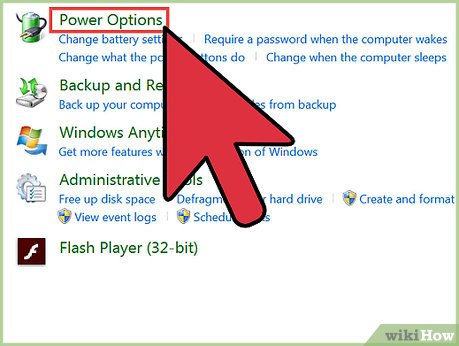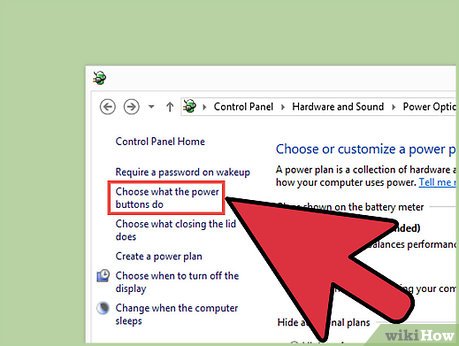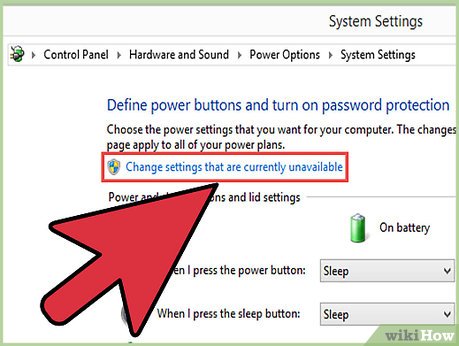How to Enable Hibernate in Windows 8
Part 1 of 3:
Adding Hibernate to the Shutdown Menu
-
 Open the Power Options menu. There are several different ways that you can quickly open this menu.
Open the Power Options menu. There are several different ways that you can quickly open this menu.- Press ⊞ Win+X or right-click on the Start button and select "Power Options".
- Open the Charms bar, select Settings, then "Change PC Settings", and then click Control Panel. Select Power Options from the Control Panel menu.
- Press ⊞ Win+R, type powercfg.cpl, and press ↵ Enter.
-
 Click the "Choose what the power buttons do" link. This is located in the left frame of the window.
Click the "Choose what the power buttons do" link. This is located in the left frame of the window. -
 Click the "Change settings that are currently available" link. You may be prompted to enter the administrator password.
Click the "Change settings that are currently available" link. You may be prompted to enter the administrator password. -
 Check the "Hibernate" box at the bottom of the window. This will enable the Hibernate option when you open the Shutdown menu. Click Save changes
Check the "Hibernate" box at the bottom of the window. This will enable the Hibernate option when you open the Shutdown menu. Click Save changes -
 Decide if you want to change the Power or Sleep button functions. By default, the Power button on your computer will completely shut the computer down, and the Sleep button will put it into Sleep mode. You can change either of these buttons to "Hibernate" by using the drop-down menus.
Decide if you want to change the Power or Sleep button functions. By default, the Power button on your computer will completely shut the computer down, and the Sleep button will put it into Sleep mode. You can change either of these buttons to "Hibernate" by using the drop-down menus.
Part 2 of 3:
Enabling Auto-Hibernate
-
 Open the Power Options menu. See the first step in the previous section for instructions on opening this menu.
Open the Power Options menu. See the first step in the previous section for instructions on opening this menu. -
 Click the "Change plan settings" link next to your active plan. Your active plan will have the selection button highlighted.
Click the "Change plan settings" link next to your active plan. Your active plan will have the selection button highlighted. -
 Click the "Change advanced power settings" link. This will open a smaller Power Options window.
Click the "Change advanced power settings" link. This will open a smaller Power Options window. -
 Expand the "Sleep" option. This will allow you to change your Sleep settings.
Expand the "Sleep" option. This will allow you to change your Sleep settings. -
 Understand the difference between the options. There are three basic sleep options you can choose from: Sleep, Hibernate, and Hybrid Sleep. The one you choose will depend on your power and resuming needs.[1]
Understand the difference between the options. There are three basic sleep options you can choose from: Sleep, Hibernate, and Hybrid Sleep. The one you choose will depend on your power and resuming needs.[1]- Sleep - Sleep mode stores all of your open programs in the computer's RAM and then enters a low-power mode. You can quickly resume your computer within a few seconds. If you're using a laptop, this will still drain your battery, though much slower than if the computer was use.
- Hibernate - All of your open programs are stored to the hard disk and then the computer is completely shut down. This will draw zero power, as opposed to Sleep mode which has a small power draw. You'll still be able to resume your week like Sleep mode, but starting up will take a few seconds longer.
- Hybrid Sleep - This is a combination of Sleep and Hibernate, and is designed for desktop computers that are always plugged in. The open programs and documents are stored to both the memroy6 and the hard disk, and then the computer is put into a low-power state. In the case of a power outage or interruption, you can still resume because the data was stored on the hard disk.
-
 Expand the "Hibernate after" option and set a time. This will let you set how long your computer will idle before it switches to Hibernate.
Expand the "Hibernate after" option and set a time. This will let you set how long your computer will idle before it switches to Hibernate.- If you don't see the "Hibernate after" option, click the "Change settings that are currently unavailable" link at the top of the window. You may be prompted for the administrator password.
- Consider using Hybrid Sleep if you have a desktop instead of Hibernate. Your desktop will reboot faster, but it will take slightly more power than Hibernate. You can enable Hybrid Sleep by expanding the "Allow hybrid sleep" option.
-
 Set "Sleep after" to "Never" if you enable "Hibernate". These two will conflict with each other, so expand "Sleep after" and set it to "Never" if you enabled Hibernate in the previous step.
Set "Sleep after" to "Never" if you enable "Hibernate". These two will conflict with each other, so expand "Sleep after" and set it to "Never" if you enabled Hibernate in the previous step. -
 Click .Apply to save your changes. After your computer has been inactive for the time you specified, your computer will perform the Sleep or Hibernate action you set.
Click .Apply to save your changes. After your computer has been inactive for the time you specified, your computer will perform the Sleep or Hibernate action you set.
Part 3 of 3:
Troubleshooting
-
 Update your video card drivers. Some video cards do not support all of the Sleep options in Windows. Usually updating your drivers will enable these functions, but if your card is older you may not get the option.
Update your video card drivers. Some video cards do not support all of the Sleep options in Windows. Usually updating your drivers will enable these functions, but if your card is older you may not get the option.- Visit the video card manufacturer's website. You can determine the manufacturer by typing dxdiag into the Run box (⊞ Win+R) and selecting the Display tab.
- Download the latest driver for your video card. Both Nvidia and AMD have tools on their websites which will automatically detect your video card and download the newest drivers. You can also search the website for your specific model, which you can find in the "dxdiag" window.
- Run the installer and follow the prompts. The update process will be mostly hands-off. Your screen may shut off or flicker during the installation. Click here for more detailed instructions on updating your video drivers.
-
 Check your BIOS settings. The availability of your Sleep options is determined by your motherboard's BIOS settings. Normally, these are all enabled, but on some motherboards you may have to enable the functionality yourself. The following method of accessing your BIOS only refers to computers that came with Windows 8 installed. If you installed Windows 8 on an older machine, click here for details on accessing the BIOS.
Check your BIOS settings. The availability of your Sleep options is determined by your motherboard's BIOS settings. Normally, these are all enabled, but on some motherboards you may have to enable the functionality yourself. The following method of accessing your BIOS only refers to computers that came with Windows 8 installed. If you installed Windows 8 on an older machine, click here for details on accessing the BIOS.- Open the Charms bar and click Settings. Hold ⇧ Shift and click on the Power button. Select "Restart".
- Click the "Troubleshooting" option in the Advanced Startup menu.
- Select "UEFI Firmware Settings". Find the options that allow you to enable the various Sleep modes (locations vary by manufacturer).
4 ★ | 2 Vote















 How to Use Windows 8.1
How to Use Windows 8.1 How to Go Straight to Desktop When You Sign in on Windows 8
How to Go Straight to Desktop When You Sign in on Windows 8 How to Shut Down Windows 8
How to Shut Down Windows 8 How to Restore Windows 8
How to Restore Windows 8 How to Switch Keyboard Input Languages in Windows 8.1
How to Switch Keyboard Input Languages in Windows 8.1 How to Reduce Screen Scaling in Windows 8
How to Reduce Screen Scaling in Windows 8